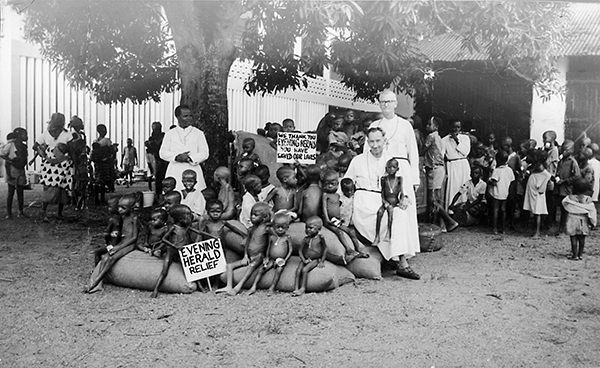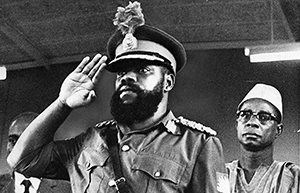Back to Biafra
Published in Issue 3 (May/June 2017), Platform, Volume 25On the 50th anniversary of a war that was headline news in Ireland.
By Kevin O’Sullivan
Biafra’s heyday was short-lived. On 30 May 1967 Lt Col. Odumegwu Ojukwu announced the secession of Nigeria’s Eastern Region (of which he was leader) and the creation of an independent republic. Within months his forces were drawn into a brutal war of attrition with Nigeria’s Federal Military Government that they had little hope of winning. The human cost was enormous: one million died on the Biafran side, many of them from disease and hunger, along with 200,000 in federal-controlled areas. On 10 January 1970, little over two and a half years after his declaration, Ojukwu fled the country, shaken by the rapid advance of Nigerian forces. Two days later his government surrendered. The dream was over.
In the five decades since its collapse the idea of ‘Biafra’ has never quite gone away. Chimamanda Ngozi Adiche’s prize-winning novel Half of a yellow sun (2007) brought the war experience to a new generation of readers in the West. When Chinua Achebe published his final book, a memoir, in 2012, he titled it There was a country: a personal history of Biafra. Biafra has also been increasingly visible in Nigerian political circles in recent years. The secessionists’ flag of black, red and green, adorned with a rising yellow sun, decorates the websites and newsletters of numerous expatriate groups across North America and Europe. Activists have recently taken to the streets in Nigeria under the same colours: Amnesty International accused Nigerian security forces of killing dozens of pro-secessionist Indigenous People of Biafra demonstrators at Onitsha in 2016.
Yet it is the memory of the humanitarian crisis that resonates most strongly from our 21st-century vantage point. Biafra was the world’s first televised famine, bringing now-familiar sights and sounds of the starving and the destitute into Western living-rooms for the first time. For a generation of Irish men and women, the word ‘Biafra’ conjures up a vivid image of missionary nuns, brothers and priests distributing food, administering medicine and bearing witness to the war’s impact among their local communities, and of the first days of Concern (originally Africa Concern), created in March 1968 by a south Dublin couple, John and Kay Kennedy, who were determined to organise a co-ordinated response to the crisis.
But what of Biafra now? What relevance does the crisis have today? Over the past four years I have worked closely with members of the international NGO community on the role of history in shaping future humanitarian practices and policies. Biafra still haunts those debates; many of its moral and political challenges remain unresolved, marked by a well-intentioned naivety that the sector just can’t shake. Yet, as we stand waist-deep in a worsening global humanitarian emergency in 2017, looking back to Biafra offers important lessons for the future of aid.

Above: September 1968—Holy Ghost missionaries and Biafran children pose for a photo promoting the Evening Herald’s fund-raising appeal. For a generation of Irish men and women, the word ‘Biafra’ conjures up such images of missionary nuns, brothers and priests distributing food, administering medicine and bearing witness to the war’s impact among their local communities. (Holy Ghost Fathers)
First, it helps us to understand the limitations of the NGO community, and to recognise when to direct our attentions elsewhere for solutions to humanitarian catastrophe. There are obvious parallels between the abuse of humanitarian norms in West Africa in the late 1960s, for example, and the ongoing crisis in the Middle East today. Hospitals in Biafra—as in Syria—were bombed and strafed. Civilians became targets of war. Millions were displaced as they tried to flee the conflict. Even food was transformed into a tool of war. The hard-line approach of Nigerian Army Col. Benjamin Adekunle (nicknamed ‘the Black Scorpion’) was not untypical of the regime: he would, he warned, ‘prevent even one Igbo having one piece to eat before their capitulation’.
That hard-line approach was matched by the major powers’ determination to do as little as possible to lessen the conflict’s human cost, especially if it meant lengthening the crisis or interfering with their geopolitical goals. British authorities provided the Federal Military Government with weapons, for example, while Egyptian pilots flew Soviet-supplied aircraft for its air force. The interests of international oil companies were never far from the agenda either. Shell had made a major investment in Nigeria immediately before the war’s outbreak.
Second, and relatedly, it leads us to ask how NGOs respond in the face of political manipulation of aid. Biafra became a cause célèbre in the West in the late 1960s. Some campaigned against the brutality of the conflict, focusing on the excessive use of force by Nigerian forces. Others were more concerned at the humanitarian crisis taking hold across a rapidly shrinking Biafran territory. Many linked the two, describing the Nigerian blockade of Biafra as akin to a genocidal campaign against the region’s largest ethnic group, the Igbo. In the rush to help, however, many in the NGO community were blinded to (or chose not to see) some of the Biafran regime’s less-than-savoury traits. Ojukwu’s determination to gather support by playing on the hearts and minds of the Western public put famine centre stage. But it came at a terrible cost: the longer the Biafrans held out, the worse their living conditions became. Whether the humanitarian community understood the implications of their actions is another question: they found themselves embroiled in similarly politically charged debates in Ethiopia in the mid-1980s, and again in Somalia at the beginning of the following decade. What lessons, one might ask, have aid agencies learned as they try to deal with the difficult political situation in the contemporary Middle East?

Above: Lt Col. Odumegwu Ojukwu—on 30 May 1967 he announced the secession of Nigeria’s Eastern Region (of which he was leader) and the creation of an independent republic of Biafra.
Kevin O’Sullivan is a Lecturer in History at the National University of Ireland, Galway, and the holder of an Irish Research Council New Foundations Civic Society Grant for his collaboration with Trócaire, ‘Humanitarian History: Past Practice Into Future Policy’.
















